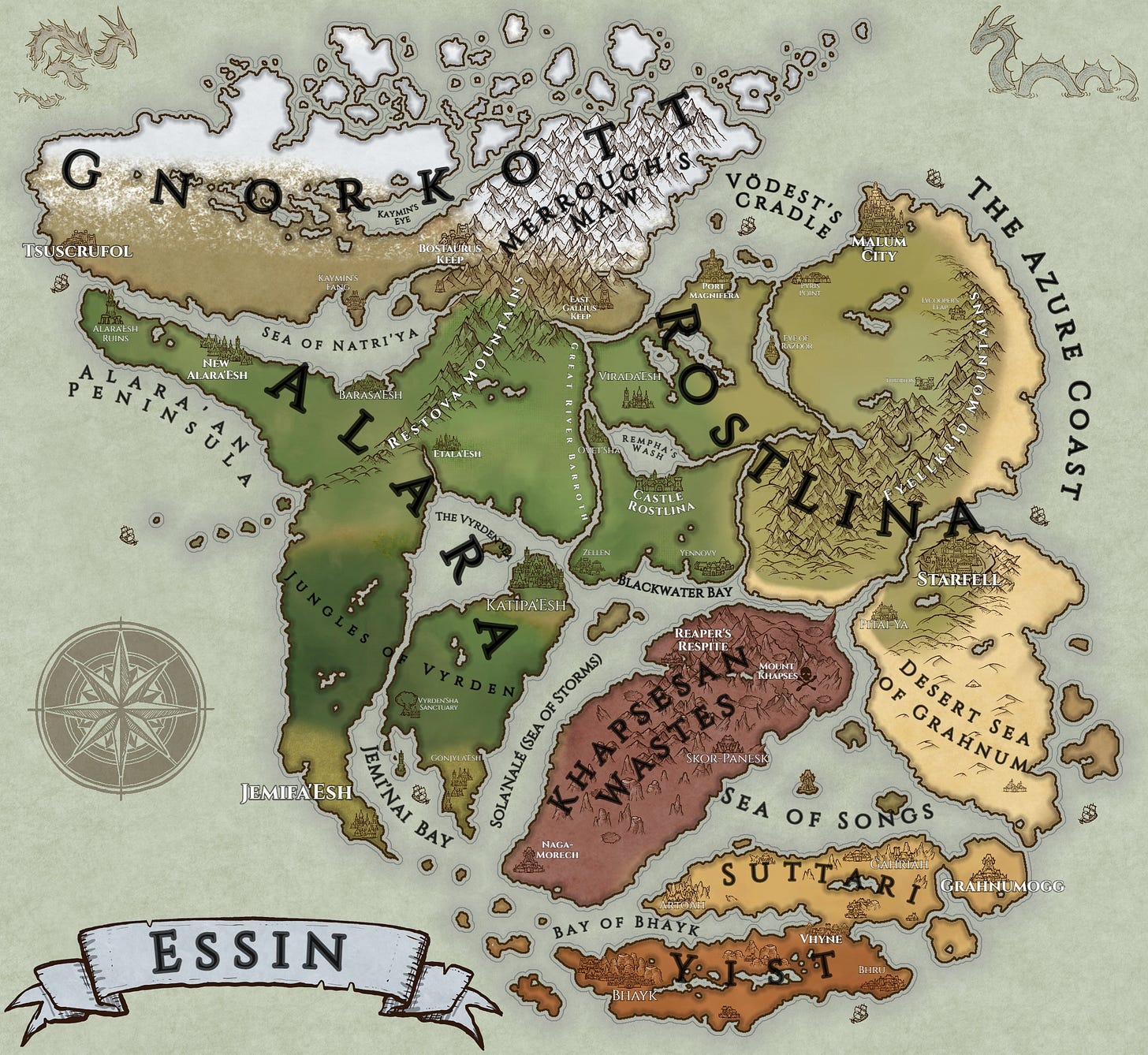Across the shining deserts of Grahnum, over the dungeon-haunted planes of Parapetia, into the frigid wastes of Merrough’s Maw, the lands of Essin are filled with adventure. After centuries of uncertainty and conflict, the nations of Essin finally settled into a stable, lasting peace. Yet, there are plenty of opportunities for heroic deeds. The kingdoms of the past, their people, and especially their wars… their effects can still be felt today, and could prove profitable to a savvy adventurer.
Before Drew and I created Essin, we created a loose set of rules for the setting of Life in Varrius Vale. Though that comic proved to be more difficult than we’d hoped—and is unfortunately on hiatus for the time being—the world we began shaping really stuck with us. We never really stopped thinking about it, and I found inspiration for our new world in basically every nook and cranny.
Now, Drew and I have tried worldbuilding dozens of times. In the fourteen years we’ve been together, we’ve probably started crafting at least 20 different fictional settings for stories we never got around to finishing. Sci-fi, fantasy, urban mystery… you name it and we’ve likely made up one setting or another that has elements of any given genre. There are a few we kept coming back to, but we almost always get hung up in the details, and then life will inevitably get in the way, and the fictional world gets put on the backburner.
That didn’t really happen with Essin though. Sure, the primary project—Life in Varrius Vale— got put on hold, but we never stopped talking about this one. It never fell off in the way the others did. We kept talking about it with our friends, and I even wrote short stories set in Essin. Something about this one kept us coming back.
Maybe it was the simplicity. One of my goals when we were constructing Essin was to make the world make sense, and make sense in a simple, easy-to-understand way. Now you may say that’s not really something to strive for in a fantasy setting, but I’d argue the exact opposite. Allow me, if you will, to ramble for a bit:
What’s the single most famous fantasy setting? It’s Middle Earth (or Arda, if you know your stuff) without a doubt. Tolkien’s Legendarium was built purely so he could have a venue to tell stories and present songs in his constructed language. Now, it’s not the first constructed fantasy world in fiction, and in fact, it’s not even an entirely fantastical, non-earth world, like D&D’s Forgotten Realms or WoW’s Azeroth. So why is it special? Aside from Tolkien’s attention to detail and brilliant character writing, I’d say Middle Earth is special because it is so very simple.
If you’ve read the Silmarillion (and I’m not here to say you should, it’s really not for everyone) you’d know that the creation myth and cosmology of the legendarium is pretty shockingly simplistic. There are fourteen Valar—not Gods, Tolkien was very Catholic—who embody the aspects of existence which shape every aspect of Arda. These Valar have very distinct domains and very limited ways in which they interact with the world, but they are well known to the elves, who thereby taught men, dwarves, and hobbits of their lore. These are pretty much the only beings worshipped as gods in Arda, and with good reason: They once walked among their worshipers.
I realize I’ve been rambling for more than a bit, but it’s kind of hard to get this point across in just a few sentences. Basically, I was kind of astounded that the single most influential fantasy world could be so easy to understand (assuming of course you don’t force yourself to learn spoken Quenya or Sindarin) and that later, more detailed fantasy settings were so comparatively complicated.
Essentially, I wanted Essin to be very accessible in all the ways I can appreciate in a setting. There needn’t be 16 Elemental planes, 700 demiplanes, 36 gods for mankind, 3 different pantheons for orcs, and ages upon ages of empires whose names are too similar to tell apart…
No, our world would be easy to come to terms with. I settled on nine major deities, one for each “playable” race, and each of those roughly corresponding to one part of the classic alignment chart.
I don’t hate settings like The Forgotten Realms or anything like that, but they are not particularly friendly to newcomers. I know, too, that limiting the number of races and monsters and gods and whatnot might put some people off. “Oh, there aren’t serpent-tiger people in this setting?” Well, no, I’m afraid not. If I put it in Essin, it has to make sense, both with the cosmology, and with world history.
All that is to say, I structured this world with ease of understanding and consistency in mind. Now, you may be wondering about that “cozy” part in the subtitle above. Well, that’s more about the kinds of stories we want to tell in this world. Drew and I are absolutely in love with all the Shire scenes from the LOTR films, and we wanted to capture that feeling and use it to tell different kinds of fantasy stories. Ones about small town life, and the adventures of homesteading or starting a family.
That’s not to say there aren’t epic tales to be experienced out in Essin. No, there are plenty of those, and a few I want to get on paper ASAP! Yet, Essin started as a setting for a story about two adventurers who retire to the quietest village they could find, and in the end, that’s what it’s best suited for.
Enough of my bloviating for now! Stay tuned for further updates as we share more details about Essin’s races, regions, and history, hopefully accompanied by Drew’s wonderful art!




